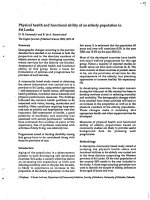The preference of a Female Greek island population in regard to the gender of their gynecologist pdf
Bạn đang xem bản rút gọn của tài liệu. Xem và tải ngay bản đầy đủ của tài liệu tại đây (148.31 KB, 9 trang )
WWW.HSJ.GR – HEALTH SCIENCE JOURNAL ® VOLUME 4, ISSUE 1 (2010)
The preference of a Female Greek island population in regard
to the gender of their gynecologist
Maria Noula
1
, Athina Leontzini,
2
Anastasis Anastasiadis
3
,Eleni Ifanti
4
1. RN, Associate Professor, Nursing Department of TEI, Lamia
2. RN , Nursing Department of TEI, Lamia
3. Resident Doctor, Obstetrics-Gynecology Department, General Hospital of Tripoli
4. Health Visitor, ΜSc, Laboratory Cooperator of Nursing Department of T.E.I., Lamia
Abstract
Background. Doctor’s gender is thought to play some role when women select their
gynecologist.
Purpose. The purpose of this research was to investigate the preference of Greek women in
regard to the sex of their gynecologist as well as the factors associated with that preference.
Material and method. The population of the study consisted of two hundred women from the
broader area of the island of Chios. A self completed questionnaire which included demographic
data, the usage of gynecological health care services as well as the choice of the obstetrician –
gynecologist was used . Descriptive statistics , x
2
and t-test, and a logistic regression model were
applied. SPSS 13.0 v was used.
Results. The average age of the 200 women of the sample was 43 ± 11.02 years. 45 % of the
participants didn’t report any sex preference, whereas 25% of them reported that they preferred
a man and 30% a woman gynecologist. Single women preferred a male gynecologist with
statistically significant difference. The women conducting an annual Pap smear check
preferred a man in their majority (28 out of 45 women), whereas the ratio changed in favor of
the female gynecologist, when the test was conducted less regularly. When the logistic
regression model was applied, the strongest correlations were as follows: Women who had
visited a gynecologist before they reached 20 years of age were 1.2 times more likely to choose
a woman gynecologist (Confidence Interval, CI 1.02 – 1.41) in comparison to the women who
were 2 years older. Those who underwent a physical breast examination at rare occasions were
1.7 times more likely to choose a woman gynecologist (CI 1.1 – 2.63) in comparison with the rest
of the sample.
Conclusions. The women obstetricians – gynecologists are ahead in the women’s preferences,
whereas half of the women think that the sex factor is rather insignificant. The older age at the
first visit and the sparse physical breast examination are positively correlated with choosing a
woman gynecologist.
Keywords: Obstetrics and Gynecology, sex, woman’s health
Corresponding author:
Noula Maria,
Pellis 3 145 61,
Kifisia Athens
Tel./Fax 210 8087573
Mobile :6932 461903,
e-mail:
The preference of a Female Greek island population in regard to the gender of their gynecologist 57
pp:57-65
E-ISSN:1791-809X www.hsj.gr
Health Science Journal® All Rights Reserved
WWW.HSJ.GR – HEALTH SCIENCE JOURNAL ® VOLUME 4, ISSUE 1 (2010)
Introduction
he relationship between the
gynecologist and the female patient
tends to be a long term one. This
doctor-patient session constitutes a kind of
social relationship during which the sex of
the two parties often plays an important
role, especially if the doctor examines the
patient’s genitals.
1,2,3
Even though a number of studies have
dealt with the issue of the factors that
influence the choice of the gynecologist,
there is no consensus on the role the sex of
the doctor plays in the choice the patient
makes. Besides, many researchers have
found that, no matter the sex choice, the
patients, regardless of their age, assess more
important characteristics such as the
doctor’s behavior and his/her scientific
background.
4,5
Since 1974, when an article
by Neubardt, "Women's Liberation and the
Male Gynaecologist," discussed women's
dissatisfaction with the
medical profession
and the need for female gynaecologists,
many studies have shown that there is a
continued
need for gender equality in the
field of obstetrics and gynecology.
6
As the literature suggests, about half
of the women do not care about their
gynecologist’s sex, whereas only a small
percentage, ranging from 1.2 to 6%, would
choose a male gynecologist.
7-10
Fischer
demonstrated that 75%
of patients surveyed
reported no "strong preference concerning
the gender of their obstetrician-
gynecologist."
9
This same 2002
study showed
that 4% of respondents preferred male
providers, while
21% had a preference for
female providers. In a 2002 survey
of
postpartum patients , Howell et al.,
4
reported similar findings
for gender
preferences. Overall, 34% of respondents
preferred
a female obstetrician, 7% a male
obstetrician, and 58% expressed
no gender
preference.However, we must note that a
15-25% of the women consider the sex of the
doctor to be an important factor in choosing
their gynecologist.
3,10,11
Furthermore, gender could make a
significant difference in the type of services
offered. For example, one survey of 2525
women in the United States reported that
patients of female general practitioners or
internists were more likely to receive a Pap
smear than were patients of male general
practitioners.
6
The matter of the preference of the
gynecologist based on sex does not have only
an academic interest, but also a practical
one for the medical community, since it
affects the decision for the doctor’s
specialty. The number of men who wish to
become gynecologists worldwide, in the last
2 decades is decreasing steadily, especially
in the USA, where the percentage decreased
from 53.5% in 1990 to 24% in 2005.
11
In Greece however, the number of
female gynecologists is still small, with just
455 in a total of 2,547 in 2006.
12
In case of
stabilization of the preference of the female
population to female gynecologists, those
percentages could change. The purpose of
this study was to investigate the preferences
of Greek women in regard to the sex of their
gynecologist, as well as the factors related
to that preference.
Material and Method
Two hundred women participated in
this research. The workplaces where the
data were collected were a public hospital,
the central offices of some banks and some
private companies. Initially, the women, as
well as their supervisors were informed
regarding the purpose of the study and then
the questionnaires were handed out to the
women who were interested in participating.
Moreover, it was made clear that the data
were collected confidentially and that no
person could be identified from the results of
the study. The data were collected from
December of 2006 to January of 2007.
A closed –type questionnaire,
consisted of 29 questionnaires was used.
The questionnaires were completed in the
presence of the female researchers, to whom
the participants could ask explanatory
questions. The questionnaire was created
T
The preference of a Female Greek island population in regard to the gender of their gynecologist 58
pp:57-65
E-ISSN:1791-809X www.hsj.gr
Health Science Journal® All Rights Reserved
WWW.HSJ.GR – HEALTH SCIENCE JOURNAL ® VOLUME 4, ISSUE 1 (2010)
after a review of the foreign literature,
based on the questionnaires of other studies
dealing with the same or similar subject. It
contained questions regarding the
demographic data of the subjects, the use of
gynecological Health Care Services as well as
the choice they make regarding their
obstetrician – gynecologist. The questions
deal with the choice of the doctor, the
sources of information regarding the doctor,
the reasons that led to them choosing that
particular doctor, as well as the
characteristics that the Greek women desire
their doctor to possess.
13
Statistics
Initially, a descriptive statistical
analysis was conducted and contingency
tables were formed on the questioned
variables. The x
2
test was used on the
qualitative variables and the t-test on the
quantitative variables. From the total of the
examined variables, the ones that presented
a significant statistic correlation with the
choice of the sex of the gynecologist were
identified. The choice of the sex (male-
female) was considered as a dual variable
and we entered the variables correlated
significant statistically with the choice of the
sex into a logistic regression model. In that
model, it was shown that eventually only a
few variables were correlated significant
statistically with the choice of the sex of the
doctor. The statistic model SPSS, 13.0 for
Windows was used in order to draw the
conclusions of this research.
Results
200 women took part in the study.
The average age of the women of the sample
was 43±11.02 years old, with 18 years being
the minimum and 71 the maximum age.
Eighty seven percent (174) of the women
were married, with an average age of
42±10.52 years (Table 1). The average age of
the single women was 34±12.01 years. A
55.5% had 1-2 children. A 79.5% (159) of the
women were working , while 87.1% of the
women reported up to 1,500 € as their
monthly income. Regarding their educational
level, 5% were Elementary graduates, 12.5%
were Junior High School graduates, 45% were
High School Graduates or Technical School of
secondary education graduates, 36%
University or Higher Technical Educational
Institute graduates, while 3% of the
respondents reported they had completed
their post-graduate studies (Table 2).
Forty –five percent of the women who
participated in the research did not have a
preference based on the sex of their doctor,
whereas 25% of them stated they preferred a
man and 30% a woman (Table 3). Regarding
the correlation of the sex preference with
the family status, the single women
preferred a male gynecologist with a
significant statistic difference (Table 4). The
age of the first visit to the gynecologist was
correlated with the choice of the sex of the
doctor, since the women who had visited a
gynecologist before they reached an average
20 years of age (19.71) preferred a man,
with a significant statistic difference in
comparison to the women who were 2 years
older (21.76) (Table 5). The age group 58-73
years old (born in the period 1951-1960)
preferred a female gynecologist, with a
significant statistical difference compared
to women who were 28-58 years old. The
majority of the women of age 18-28 years
old also preferred a male gynecologist (Table
6). The women who conducted regular breast
exams (every year) stated that they
preferred a male gynecologist (25 out of 32
women) in contrast to the women who
conducted the exam less regularly, who
preferred a female gynecologist (Table 7).
We found similar results for the
women who conducted regular Pap tests.
The women who were conducting an annual
check preferred a man in their majority (28
out of 45 women), whereas the ratio
changed in favor of the female gynecologist,
when the test was conducted less regularly
(Table 8).
As seen in Table 9, based on the
results from the analysis of a logistic
regression statistic model, in which we
included the variables that initially
correlated with the choice of the sex and
The preference of a Female Greek island population in regard to the gender of their gynecologist 59
pp:57-65
E-ISSN:1791-809X www.hsj.gr
Health Science Journal® All Rights Reserved
WWW.HSJ.GR – HEALTH SCIENCE JOURNAL ® VOLUME 4, ISSUE 1 (2010)
using as a dependent variable the potential
preference of a male gynecologist, the age
of the first visit and the breast exam
presented, in comparison to the others, the
largest statistically significant correlation
at a significance level p<0.05 with the sex of
the gynecologist. The women who visited a
gynecologist in a younger age were, by
average, 1.2 times more likely to choose a
male gynecologist (CI1.02-1.41). The women
who were conducting less regular breast
exams were, by average, 1.7 times more
likely to choose a female gynecologist (CI1.1-
2.63).
Discussion
In this research, it was found that
about half of the women exhibited a
preference based on the sex of their
gynecologist, with their majority choosing a
female gynecologist. The above finding is in
agreement with the results of the
international literature, from which we can
draw the conclusion that most women prefer
female gynecologists.
4-9
However, the percentage of women
who do not have a preference based on sex
or they do not consider it to be a decisive
factor in their final choice is often larger,
sometimes even reaching 75%.
9
That fact is
often attributed to stereotypes and
prejudices that exist in every society
regarding the qualities of the sexes, and
which in many cases influence the behavior
of people in their social relationships.
According to the literature, the patients
believe that a female gynecologist is more
compassionate and largely possesses the so
called humanitarian values, whereas there is
the conviction that men are more capable on
“technical issues” and more rigid .
1,14-16
It has also been found that women
devote more time to the patient, they talk
more to her and they focus more on her
feelings than men. Moreover, they are
friendlier to the patient and they encourage
her to express herself and be a part of the
therapeutic process.
17-21
Since the patients
consider women stereotypically to be more
humane, it has been found that 83% of
women choose a female gynecologist, based
on the display of photographs, without any
additional information.
11
In the study of Roter et al.,
21
and in
a sample of 612 women , more than 50%
reported that they preferred a female doctor
on health issues of gynecological nature
21
These results agree with the findings of the
study of Nichols
22
of conducted in a sample
of 2,000 women, where 54% of the
participants reported that they preferred a
female doctor to take their Pap smear, 48%
that they preferred a woman for their breast
exam and 36% that they preferred a woman
to take a sample of vaginal fluid for
culture.
22
The same is true even in the case
of a student or a resident being present
during the gynecological exam, which
supports the role of the social factors. The
first question deals with the presence of
students during a gynecological exam, where
77.34% of the respondents stated that they
did not mind the presence of female
students, whereas only 51.4% said that they
would allow male students to be present
during the exam of their genitals, which
makes a statistically significant difference.
3
Moreover, in another research conducted
on 1,078 women, even though 92% of the
respondents would allow a female resident
gynecologist to examine them, only 69%
would be willing to be examined by a male
resident gynecologist. Therefore, there are
women who emphasize more on the sex of
the doctor, than on his/her level of
education.
23
However, the way the patients choose
their doctor is not fully understood and it is
contradictable in many occasions. Besides,
we should point out that, in many cases, the
patients eventually pick a male gynecologist,
even if they have answered that they would
prefer a woman in the related question. As it
is concluded by the studies that have dealt
with the matter of the choice of the
obstetrician-gynecologist, the
recommendations by friends and colleagues,
the clinic the doctor is working at and
his/her academic skills, and also his/her bed
manners are more important factors than the
sex. Most patients do not have a gender
The preference of a Female Greek island population in regard to the gender of their gynecologist 60
pp:57-65
E-ISSN:1791-809X www.hsj.gr
Health Science Journal® All Rights Reserved
WWW.HSJ.GR – HEALTH SCIENCE JOURNAL ® VOLUME 4, ISSUE 1 (2010)
preference and wish their doctor to possess
knowledge, skills and experience.
4,24,25
The
educational level, the ethnicity, the religious
beliefs, the cultural traditions and the
socioeconomic status play some role in the
choice of the gynecologist. Professionalism
and courtesy come ahead as criteria, in
relation to the doctor’s academic skills and
his/her availability.
1
The findings of this study allow us to
conclude that parameters such as the family
status, the frequency of conduction of
clinical / para-clinical exams, as well as the
age of the first trip to the gynecologist are
correlated with the choice of the sex.
Indeed, studies have attempted to reveal a
connection between the demographic
information of the respondents and their
preference of the sex of their doctor. It
seems that the sex of the doctor is more
important to younger women who don’t have
any children.
3,23
A possible explanation for
that phenomenon could be that a woman of
older age is ,on one hand, more familiar with
the process of the gynecological exam and,
on the other hand, considers other qualities
of the doctor, such as knowledge and
experience, to be more important than
his/her sex.
It is concluded that the older age, the
family status (married) and the birth history
are correlated with the long term
relationship with the gynecologist. That can
be attributed to the different needs of
married women, who were satisfied with the
prenatal care, and that is why they continue
visiting the same obstetrician-gynecologist
over the years
1
. It has also been found that
single women and women who have had
children tend to prefer male gynecologists.
1
The women of the sample, who
visited the gynecologist for the first time
when they were averagely under 20, seem to
prefer a male gynecologist. That can possibly
be attributed to the fact that under 20 years
of age, the frequency of marriage, as well as
procreation is small (in our sample none of
the women under 20 was married). It has
also been found that women consider men to
be more appropriate for handling surgical
procedures, whereas c-sections are
conducted more frequently by men.
16,26
It is possible that the invasive nature
of exams such as the Pap smear or the skills
required for examining the breast make
women follow some stereotypes in their
choice of a male gynecologist.
A factor that should be taken under
consideration in assessing the results of this
study is the small number of Greek female
gynecologists, that is significantly smaller
than in other countries, which could, to an
extent, explain the increased,
proportionally, preference of male
gynecologists in relation to other countries.
Indeed, according to the data from Greek
Medical.Association ( GMA), in 2006, there
were only 445 women gynecologists, whereas
the men were 2,092.
12
Conclusions
Τhe women obstetricians-
gynecologists come ahead in the preference
of women, noting that about half of the
women consider sex to be a rather
unimportant factor. The younger age during
the first visit and the regular breast exam
are positively correlated with the choice of a
male gynecologist. Other parameters, such
as the woman’s age, her family status, and
also the frequency she is conducting a Pap
test, also play a potential role in the choice
of the sex of the gynecologist.
Bibliography
1. Piper I, Shvarts S, Lurie S. Women's
preferences for their gynaecologist or
obstetrician. Patient Educ Couns. 2008
;72(1):109-14
2. Donahue KE, Ashkin E, Pathman DE.
Length of patient-physician relationship
and patients' satisfaction and preventive
service use in the rural south: a cross-
sectional telephone study. BMC Fam
Pract. 2005;4(6):40
3. O’ Flynn N, Rymer J. Women’s attitude
to the sex of medical students in a
gynaecology clinic: cross sectional
surney. BMJ. 2002 ;325(7366) :683-684.
The preference of a Female Greek island population in regard to the gender of their gynecologist 61
pp:57-65
E-ISSN:1791-809X www.hsj.gr
Health Science Journal® All Rights Reserved
WWW.HSJ.GR – HEALTH SCIENCE JOURNAL ® VOLUME 4, ISSUE 1 (2010)
4. Howell EA, Gardiner B, Concato J. Do
women prefer female obstetricians?
Obstet Gynecol. 2002;99(6):1031-5.
5. Cassard SD, Weisman CS, Plichta SB,
Johnson TL. Physician gender and
women’s preventive services. J Wom
Health 1997;6(2):199.
5. Chandler PJ, Chandler C, Dabbs ML.
Provider gender preference in obstetrics
and gynecology: a military population.
Mil Med. 2000;165(12):938-40
6. Schmittdiel J, Selby JV, Grumbach K,
Quesenberry CP Jr. Women's provider
preferences for basic gynecology care in
a large health maintenance organization.
J Womens Health Gend Based Med. 1999;
8(6):825-33
7. Webb R, Opdahl M. Breast and pelvic
examinations: easing women's
discomfort. Can Fam Physician. 1996
;42:54-8
8. Zuckerman M, Navizedeh N, Feldman J,
McCalla S, Minkoff H. Determinants of
women's choice of
obstetrician/gynecologist. J Womens
Health Gend Based Med. 2002;11(4):175-
80
9. Fisher WA, Bryan A, Dervaitis KL, Silcox
J, Kohn H. It is not necessarily so: most
women do not strongly prefer female
obstetrician-gynaecologists. J Obstet
Gynaecol Can. 2002;24(9):885-8
10. Kerssens JJ, Bensing JM, Andela MG.
Patient preference for genders of health
professionals. Soc Sci Med. 1997
;44(10):1531-40
11. 11.
Schnatz PF, Murphy JL, O'Sullivan DM,
Sorosky JI. Patient choice: comparing
criteria for selecting an obstetrician-
gynecologist based on image, gender, and
professional attributes.
Am J Obstet
Gynecol.
2007;197(5):548.e1-7
12. GreekMedicalAssociation files, 2006
13. Davou E, Katostaras T. Greek woman’s
preference regarding their
gynaecologist’s age. Obstetrics and
Gynaecology Issues 2006; 1(1) :44-47.
14. 14.
Plunkett BA, Kohli P, Milad MP. The
importance of physician gender in the
selection of an obstetrician or a
gynaecologist.
Am J Obstet Gynecol. 2002
;186(5):926-8.
15.
Johnson AM, Schnatz PF, Kelsey AM,
Ohannessian CM. Do women prefer care
from female or male obstetrician-
gynaecologists? A study of patient gender
preference.
J Am Osteopath Assoc. 2005
;105(8):369-79.
16.
Rizk DE, El-Zubeir MA, Al-Dhaheri AM, Al-
Mansouri FR
, Al-Jenaibi HS.Determinants
of women's choice of their obstetrician
and gynaecologist provider in the UAE.
Acta Obstet Gynecol Scand. 2005
;84(1):48-53.
17. Uskul AK, Ahmad F. Physician-patient
interaction: a gynaecology clinic in
Turkey. Soc Sci Med. 2003;57(2):205-15.
18. Roter DL, Hall JA, Aoki Y. Physician
gender effects in medical
communication: a meta-analytic review.
JAMA. 2002;288(6):756-64.
19. Hall JA, Debra RL. Do patients talk
differently to male and female
physicians? A meta-analytic review.
Patient Educ Couns 2002; 48(3):217-224.
20. Bylund CL, Makoul G. Empathic
communication and gender in the
physician-patient encounter. Patient
Educ Couns. 2002;48(3):207-16.
21. Roter DL, Geller G, Bernhardt BA, Larson
SM, Doksum T. Effects of obstetrician
gender on communication and patient
satisfaction. Obstet Gynecol.1999 ;93(5Pt
1):635-41.
22. Nichols S. Women’ s preference for sex of
doctor: a postal surney. J R Col Gen Pract
1987;33(305):540-43.
23. Phillips D, Brooks F. Women patients'
preferences for female or male GPs. Fam
Pract. 1998;15(6):543-7.
24. Rifkin JI, Shapiro H, Regensteiner JG,
Stotler JK, Schmidt B. Why do some
women refuse to allow male residents to
perform pelvic exams? Acad Med.
2002;77(10):1034-8.
25.
Franks P, Bertakis KD. Physician gender,
patient gender, and primary care.
J
Womens Health (Larchmt).
2003;12(1):73-80.
The preference of a Female Greek island population in regard to the gender of their gynecologist 62
pp:57-65
E-ISSN:1791-809X www.hsj.gr
Health Science Journal® All Rights Reserved
WWW.HSJ.GR – HEALTH SCIENCE JOURNAL ® VOLUME 4, ISSUE 1 (2010)
26. Mitler LK, Rizzo JA, Horwitz SM. Physician
gender and cesarean sections.
J Clin
Epidemiol.
2000 ;53(10):1030-5 .
Appendix
Table 1. Distribution of the sample according to their age
Ν % Μean( ± SD),
min-max
Age (years) 200 100,0 43 ± 11,02
71-18
Age of married
people
174 87,0 42± 10,52
Age of unmarried
people
26 13,0 34± 12,01
Total 200 100,0
Table 2. Distribution of the sample according to their socio-demographic data
Sociodemographic data Ν %
Number of children
None 55 27,5
One 34 17,0
Two 77 38,5
>3 34 17,0
Total 200 100,0
Employment
Yes 159 79,5
No 41 20,5
Total 200 100,0
Monthly income
< 500 euros 32 16,5
500-1000 70 36,1
1000-1500 67 34,5
1500-2000 16 8,3
> 2000 9 4,6
Total 194 100,0
Educational level
Elementary graduates 10 5,0
Junior high school
graduates
25 12,5
High school and
technical schools
90 45,0
Universities/TEI 72 36,0
Post-graduate studies 3 1,5
Total 200 100,0
The preference of a Female Greek island population in regard to the gender of their gynecologist 63
pp:57-65
E-ISSN:1791-809X www.hsj.gr
Health Science Journal® All Rights Reserved
WWW.HSJ.GR – HEALTH SCIENCE JOURNAL ® VOLUME 4, ISSUE 1 (2010)
Table 3. Distribution of the sample according to gender
Gender Ν %
Man 50 25
Woman 60 30
No preference 90 45
Total 200 100
Table 4. Family status and gender preference crosstabulation
Family status Gender preference P
Man Woman
Yes 46 46 Engaged /Married
No 4 14
Total 50 60
0.039
x2
Table 5. Age of first visit and gender preference
Gender
preference
N P
Age of first visit Men 42 19,71
Women 46 21,76
0.009
Total 88
t- test
Table 6. Contingencies between women’s age and gender related preference
Gender
preference
Age group ( birth decade)
P
1945-
1950
1951-
1960
1961-1970 1971-1980 1980-today
Men 4 4 20 15 7
Women 5 14 16 10 15
Total 9 18 36 25 22
0.005
The preference of a Female Greek island population in regard to the gender of their gynecologist 64
pp:57-65
E-ISSN:1791-809X www.hsj.gr
Health Science Journal® All Rights Reserved
WWW.HSJ.GR – HEALTH SCIENCE JOURNAL ® VOLUME 4, ISSUE 1 (2010)
x2
Table 7. Frequency of mammary examination and gender preference
Every
year
Every two
years
Less often
Never P
Gender
preference
Man 25
5
12
8
Woman
7
14
12
27
Total
32
19
24
24
0.005
x2
Table 8 .Test Pap frequency and gender preference
Gender preference P
Man Woman
Test Pap Every year 28 17
Every two years 11 16
Less often 8 10
Never 3 17
0.005
Total 50 60
x2
Table 9. A statistical model of logistic regression , for gender gynecologist choice probability
(man =1, woman=2)
Variable Odds ratio 95% CI for Exp(B) R P
Lower Upper
Married 4.94 0.84 28.86 0.10 0.08
Age of first visit
1.20 1.02 1.41 0.15 0.02
Test pap
examination
1.26 0.76 2.09 0.00 0.38
Mammary
examination by
gynecologist
(never=3
regularly=0)
1.70 1.10 2.63 0.17 0.02
Age group 1.02 0.61 1.69 0.00 0.95
Age group 1.02 0.61 1.69 0.00 0.95
The preference of a Female Greek island population in regard to the gender of their gynecologist 65
pp:57-65
E-ISSN:1791-809X www.hsj.gr
Health Science Journal® All Rights Reserved









